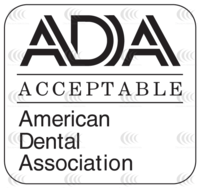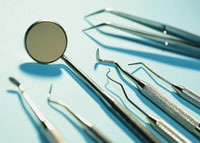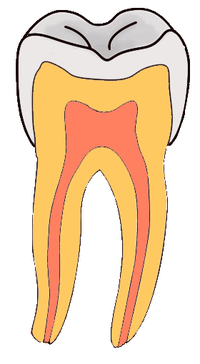Products to fight tooth decay
Introduction
Over the course of human history, humans have been dealing with chronic condition of tooth decay, caused largely by the bacteria streptococcus mutans and the biofilm it forms. A wide variety of products, techniques, and methods to fight tooth decay have been developed and analyzed over the years.
History of Tooth Decay
There is evidence of dental care from thousands and thousands of years ago as humans have struggled against tooth decay. From the Ancient Egyptians to 19th century Europe, various products and methods to fight tooth decay were discovered and used to keep teeth healthy.
Ancient Dental Care
Remains from more than 8,000 years ago, originating in current Pakistan, show evidence of cavity drilling to reduce pain. [1] Thus, though the cause and ability to prevent tooth decay was unknown to these ancient peoples, procedures to reduce pain as well as the location of the source of pain were well recognized. In Ancient Egypt, there was also not much knowledge about preventing tooth decay before it damaged the teeth, but the common diet was high in honey and sugars that are now known to aggravate decay. [2] Thus, the Egyptians were plagued with poor teeth and procedures like tooth extraction became very common for the wealthy and educated.[3] The Etruscans also had advanced dental care to deal with the results of the tooth decay, as there is evidence of the use of gold crowns and false teeth in their society.[3] Though these societies had little knowledge of preventative measures, they were able to deal with the after effects of tooth decay. The Babylonians, however, appeared to use such things as toothpicks, herbs, alcohol, and vinegar to prevent the destruction of teeth.[4] Such products more clearly inhibit the growth of bacteria and were more effective in preventing pain and loss of teeth, as they attack the source of the problem, bacteria. Though the specific microbial causes of decay were not identified in Babylonian documents, it has been found that sophisticated methods, such as rubbing mixtures of herbs and abrasives, were common practice when toothaches or pain arose.[4]
More Recent Methods of Preventing Tooth Decay
Forms of removing excess food or even plaque have been around for centuries, such as the use of toothpicks by the Greeks and Romans.[5] However, the Mediterranean diet was very low, perhaps with intention of avoiding tooth decay, in the sugars that are most often linked to the growth of plaque.[5] Because of this, unlike the Egyptians, dentistry in Roman times was not highly developed or largely researched.[5] In Medieval times, however, the diet of the elite was very high in sugar, and thus there was pressure to develop new forms of dentistry.[6] The Medieval elite invented new methods of creating false teeth for those whose teeth were damaged beyond repair, and are believed to have known some simple methods of teeth whitening. There is evidence that the dentists knew how to drill and subsequently fill cavities, as well as had developed rudimentary forms of toothpaste, then known as a tooth powder.[6] These powders mainly consisted of abrasives that would scrub away the biofilm that causes tooth decay, such as crushed oyster shells.[7] Clearly, though the cause of tooth decay was not known specifically as a bacteria biofilm, it was recognized that the scrubbing of teeth and gums would limit the decay. These abrasives were in fact too harsh, and often times the enamel would become damaged.[7]
The first “toothbrush” was first created in China using boar hair, and then brought to Europe, where the preferred toothbrush used the much gentler horsehair.[7] Later, as toothbrushes began to become mass produced in Europe, new products were found to be gentler while still being effective. The first toothbrush to use nylon bristles was manufactured in 1938 by Dupont Company.[8] The first mass produced toothpaste was introduced to the market in 1873. These early toothpastes included things like chalk or glycerin to serve as the base, borax powder to cause foam, and bicarbonate of soda to serve as the inhibitor of bacteria.[7] We now know, however, that such products are not nearly as effective as the fluoride commonly used today to prevent decay. Toothbrushing thus became a more common process in Europe following the introduction of these products on the market and was spread to the United States following World War II when American soldiers brought the process back with them.[7]Thus began the further investigation of the best chemicals and products to put in toothpaste as well as the best fibers to use in toothbrushes, eventually culminating in the practices we use today.
Modern Dentistry
Oral healthcare has evolved tremendously in the past century alone. American dentistry is now it’s own branch of medicine concerned with the study, diagnosis, prevention and treatment of diseases, disorders and conditions of the oral cavity.[9] Although dentists are primarily concerned with the maxillofacial area its adjacent structures, poor dental hygiene can also detrimentally affect seemingly unrelated organs. The neglect of proper dental care can lead to a number of health conditions, some of which can be fatal. At the crux of the good dental hygiene are bacteria. Over 700 different kinds of bacteria inhabit the human mouth at any given moment – poor dental hygiene can turn the mouth into a gateway for these potentially harmful microbes to enter the bloodstream and wreak havoc on the vital bodily processes.[10] Failure to regularly clean teeth allows these bacteria to multiply, proliferating in stubborn crannies difficult to reach without the tools of a dental hygienist. If left unchecked, these bacteria can lead to tooth decay and other, potentially fatal health issues. A study led by Professor Howard Jenkinson from the University of Bristol helped illuminate how poor dental hygiene can lead to cardiovascular issues, finding Streptococcus gordonii and Streptococcus sanguinis bacteria to be “common infecting agents.” The research suggested that mouth wounds grant microbes such as s. gordonii and s. sanguinis access to the bloodstream, where they can attach onto platelets and lead to clumping and blood clots down the line. In this way, poor dental hygiene has been linked to an increased risk of heart attack and stroke.[10] In the words of Professor Jenkinson: “It doesn’t matter how fit, slim or healthy you are, you’re adding to your chances of getting heart disease by having bad teeth.”[10]
American dentistry has grown in response to heightened demand for good oral hygiene and the American Dental Association (ADA) now helps regulate and advance the industry as a whole. The ADA seal program, which certifies the safety and effectiveness of over 300 oral health items, protects consumers from product quackery.[11] Technological and medicinal advances have also played a pivotal role in advancing dental healthcare – mechanical tools allow dental hygienists to eradicate plaque with greater precision and accuracy and anesthesiology has revolutionized dental surgery. Conventional instruments also remain important in a dentist’s arsenal; spoon excavators can are still used to remove soft carious decay on the surface of the teeth. However in order to avoid decay in the first place, the ADA recommends brushing twice a day, flossing with regularity, potentially taking fluoride diet supplements, regularly checking up with the dentist, and maintaining a balanced diet.[12]
How Tooth Decay Happens
The process of tooth decay is a simple series of events to follow. Once the process is understood avoiding tooth decay becomes a lot simpler. When a child’s first tooth develops in their mouth a new flora of bacteria is able to develop. Streptococcus sanguis is the leading bacteria in its ability to adhere to the tooth’s enamel surface. Another bacteria, Streptococcus mutans is an important microbe that forms on the surface of molars. Streptococcus mutans is an extremely important microbe to the process of tooth decay because it creates an area where other bacteria can live on the tooth’s surface. There can be up to ten billion bacteria present in the mouth of a healthy human being. This collection of bacteria is called biofilm or plaque. [13] Plaque can develop twenty minutes after a meal. It is most prominent in the crevices of molar or areas that can’t be easily accessed such as in between two teeth. [14]
The process that causes the bacteria on the teeth to be harmful is called fermentation. This is the process in which bacteria feed on the carbohydrates like sugars and starches that enter our body through the mouth. Through the process of fermentation the bacteria take in these carbohydrates and sugars and produce acids, for example lactic acid. The acid itself is the substance that affects the health of the tooth. The acid wears away at the enamel on the tooth causing a hole called a cavity to form. When a cavity is recognized a dentist can seal the hole using a filling so that bacteria will no longer be able to wear away the mineral of the tooth. But, if a cavity isn’t filled in the acid from the bacteria will continue to wear away the minerals of the tooth below its surface [14]. Eventually if the acid wears away at enough of the tooth’s mineral an abscess can form. An abscess is the result of a bacterial infection in the pulp of the tooth that leads to swelling and pus formation [15].
Tooth decay is avoidable if common oral hygiene practices are employed. Brushing teeth at least twice a day and flossing once a day is highly recommended by dental professionals. Adequate brushing and flossing practices will remove the majority of plaque on the surfaces of teeth as well as in between teeth. It is also important to limit extremely sugary foods and drinks that will provide food for bacteria therefore causing them to produce more acid. Continuously snacking on sugary foods constantly replenishes the food source for oral bacteria. Fluoride is also commonly used to protect the tooth’s surface against acid wear. In addition dental sealants can be applied to molars in an attempt to coat the rough surfaces that might accumulate bacteria and plaque. [13] If tooth decay has already developed it can usually be fixed by a simple filling from your dentist. If the cavity is too severe and has worn away too much of the tooth the patient may need a crown or root canal. The worst scenario of tooth decay could lead to removal of the tooth. [16]
Methods of Prevention
Recently, studies have been conducted which highlight the benefits certain products hold regarding the prevention of tooth decay.
Licorice Root
Stefen Gafner and his team of scientists behind the study conducted the American Chemical Society’s Journal of Natural Products have recently revealed the use of licorice root as a means of impacting dental health. According to research, licorice root is capable of both preventing and fighting tooth decay and gum disease. [17] The scientists found that two of the plant’s main compounds, licoricidin and licoricoflavan A, are capable of inhibiting the growth of decay causing bacteria [18], particularly S. mutans, a bacteria which, as previously mentioned, releases enamel-decaying acid and provides a safe-haven for other bacteria to grow. By preventing the growth of this harmful bacteria, these two compounds largely reduce risk for the production of other potentially harmful substances that require the safety of a biofilm to grow, substantially reducing the possibility of decay.
The recent study also found that licoricidin and licoricoflavan A are capable of reducing the growth bacteria linked to periodontitis. These bacteria are associated with the deterioration of the gum, bone, and tissue that help keep the teeth healthy. However, it is important to note that these compounds are not present in commonly consumed licorice candy. These candies use anise oil root rather than licorice root to provide flavoring, a substance which does not possess these valuable, decay-preventing compounds.
Although research showed that the use of licorice root is capable of preventing tooth decay, it also showed that there are risks associated with consuming its supplements. In excess, the supplements may cause raised blood pressure, lower potassium levels, and cause water/salt retention. [19]
Xylitol
Xylitol is a natural sugar alcohol found in vegetables and fruits such as berries, mushrooms and corns. It also occurs naturally in human bodies. In fact, an average size adult manufactures up to 15 grams of xylitol daily during normal metabolism! Xylitol has been used as a food sweetener since the 1960s. It has the same sweetness as sucrose (table sugar). Its powder substance can be used the same way as sugar with far fewer calories and no after-taste.
It acts as a method of prevention against tooth decay in two ways. First, it differs from glucose and fructose for its molecule has only five, instead of six, carbon atoms - most bacteria and yeast in the mouth are unable to make use of xylitol and so inhibits the growth of the bacteria that cause cavities. Xylitol also raises pH of saliva. When pH is above 7, calcium and phosphate salts in saliva start to fill into those parts of enamel where they are lacking--reverse existing dental caries!
Frequency and duration of exposure is important. A person should use xylitol gum or mints 3-5 times daily, for a total intake of 6 to 10 g grams as optimal. Gum should be chewed for about 5 minutes and mints should be allowed to dissolve. It should also be chewed immediately after a meal or a snack. Generally, for the amount of xylitol to be at decay-preventing levels, it must be listed as the first ingredient in a commercial product. Studies show that decay-causing bacterium is passed from parents to newborn children, and begin the growing in the child. Regular use of xylitol by mothers has shown significant reduction of this bacterial transmission, resulting in fewer cavities for the child. More than 35 countries have approved xylitol use in pharmaceuticals and food, including hard candies, cough syrup, chewable vitamins for children, mouth wash and toothpaste and gum. It is approved by US FDA, WHO's Joint Expert Committee on Food Additives, EU's Scientific Committee for food. For people with diabetes, since the body does not require insulin to metabolize xylitol, it produces a lower glycemic response than sucrose or glucose. This has made it a widely used sweetener for diabetic diets in some countries. However, xylitol is not safe for dogs! It may cause a rapid release of insulin, causing a sudden decrease in blood glucose, leading to vomiting, loss of coordination, seizures, coma and even fatal liver failure in some dogs.
References
1. “Prehistoric Dentistry Evidence Found,” BBC News, April 11, 2001. Accessed April 30, 2012.
3. “Did Ancient Teeth Decay?” Ancient Teeth Decay, May 28, 2008. Accessed April 29, 2012.
7.[http://h2g2.com/dna/h2g2/A2818686 “The History of Teeth Cleaning,” h2g2, July 20th, 2004. Accessed April 29th, 2012.]
9.“Specialty Definitions“ American Dental Association. Accessed May 4, 2012
11.“ADA Seal of Acceptance Program & Products” American Dental Association [Accessed May 4, 2012
12. “Oral Health Topics” American Dental Association [Accessed May 4, 2012]]
13.[Sachs, Jessica Snyder. “Good Germs Bad Germs,” New York, Douglas and McIntyre Ltd. 200. pp. 39-40.]
14.[Rosenberg, Jack D.. "Dental Health." PubMed Health. A.D.A.M. Medical Encyclopedia, 22/2/2010. Web. 9 May 2012. <http://www.ncbi.nlm.nih.gov/pubmedhealth/PMH0002050/>]
15.[Rosenberg, Jack D.. "Tooth Abscess." PubMed Health. A.D.A.M. Medical Encyclopedia, 22/2/2010. Web. 9 May 2012. <http://www.ncbi.nlm.nih.gov/pubmedhealth/PMH0002055/>]
16.["Oral Health Center." WebMD. Healthwise Inc., 17/5/2009. Web. 9 May 2012. <http://www.webmd.com/oral-health/tc/tooth-decay-topic-overview>.]
20.["Xylitol The Decay-Preventive Sweetener." California Dental Association . N.p., n.d. Web. 9 May 2012. <www.cda.org/popup/xylitol>.]
21. ["Xylitol - Xylitol questions - Xylitol is sweetener that occurs naturally ." Xylitol - Xylitol educational website created as a clearinghouse for information about the benefits of xylitol for both the general public and health professionals . N.p., n.d. Web. 9 May 2012. <http://www.xylitol.org/questions-about-xylitol>.]
Edited by Jenny Goetz, Olivia Reed, Shannon Dominguez, Victoria Munson, and Liao, Chengying
students of Rachel Larsen in Bio 083 at Bowdoin College [1]











